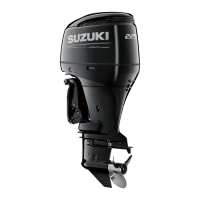ENGINE CONTROL SYSTEM 3-43
FAIL-SAFE SYSTEM
The fail-safe system is closely related to the self-diagnostic system.
When an abnormality occurs in a sensor signal, the ECM ignores the out-of-range signal and assumes a
pre-programmed value for the failed sensors.
This allows the engine to continue running under the fail-safe condition.
PRE-PROGRAMMED VALUE FOR FAIL-SAFE SYSTEM
NOTE:
There is no back-up system for the ECM itself. The engine will stop if it has failed.
NOTE 1:
This value will change according to the current engine speed.
FAILED ITEM PRE-PROGRAMMED VALUE
MAP sensor 1 • 280 – 560 mmHg (11.02 – 22.05 inHg)/(The control takes place in
accordance with the engine speed.) [NOTE 1]
CKP sensor Based on signals from CMP sensor:
• The ignition timing is controlled in 0 – 10 degree range in accordance
with the engine condition.
• Normal sequential fuel injection.
CMP sensor Based on signals from CKP sensor:
(a) Failed with engine running
• Normal ignition timing.
• Normal sequential fuel injection.
• VVT advance is fixed at the most retarded angle.
(b) Failed prior to engine start
• The ignition timing is controlled in 0 – 10 degree range in accordance
with the engine condition.
• 1 simultaneous injection for all cylinders per 2 crankshaft rotations.
• VVT advance is fixed at the most retarded angle.
Air intake system • The control is executed with the maximum engine speed as 2000 r/min.
Cylinder temp. sensor • 60 °C (140 °F)
IAT sensor • 45 °C (113 °F)
Exhaust manifold temp. sensor • 60 °C (140 °F)
Throttle position sensor • The control is executed with the throttle opening as 5 degrees.
• VVT advance is fixed at the most retarded angle.
Shift position sensor • The shift position whether neutral or other is detected with the neutral
switch signal.
• The IAC control is operated in the forward map.
CMP sensor (VVT) • VVT advance is fixed at the most retarded angle.
VVT advance • VVT advance is fixed at the most retarded angle.
• The ECM cyclically outputs the drive and stop signals for the OCV and
when the difference between the VVT’s target advance angle and the
actual advance angle has come to the normal range, the diagnostic
code display is canceled.
Model discrimination • The original model discrimination is retained.

